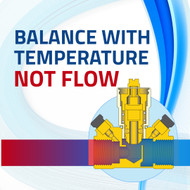In the quest for efficient domestic hot water systems, balancing is a critical factor. Ensuring that hot water is delivered promptly and at the correct temperature to all outlets in a building is vital for both comfort and energy efficiency. One of the key tools in achieving this balance is the thermostatic balancing valve (TBV). In this post, we will explore what thermostatic balancing valves are, how they function, and why balancing a system based on temperature is superior to balancing based on flow.
What are Thermostatic Balancing Valves?
Thermostatic balancing valves are specialized devices designed to maintain a constant temperature within a hot water distribution system. They automatically adjust the flow rate of hot water based on the temperature, ensuring that the desired temperature is consistently maintained across the system. This functionality is crucial in preventing issues such as thermal stratification, where layers of water at different temperatures form within the system, leading to inefficiencies and potential discomfort.
How Do Thermostatic Balancing Valves Work?
Thermostatic balancing valves operate using a temperature-sensitive element, typically a wax or liquid-filled cartridge. As the temperature of the water passing through the valve changes, the cartridge expands or contracts, mechanically adjusting the valve to increase or decrease the flow rate. This automatic adjustment ensures that the temperature remains within a specified range, providing a consistent hot water supply throughout the building.
Advantages of Balancing with Temperature Over Flow
- Enhanced Comfort and Consistency:
Balancing based on temperature ensures that all outlets receive water at the desired temperature, enhancing user comfort. With flow-based balancing, temperature variations can occur due to differences in pipe lengths and heat losses, leading to some outlets receiving water that is too hot or too cold. - Energy Efficiency:
Temperature-based balancing reduces the energy required to heat water by minimizing heat losses. In a flow-based system, maintaining the correct temperature often involves overheating the water at the source to compensate for temperature drops, leading to increased energy consumption. - Simplified Maintenance:
Temperature balancing valves adjust automatically, reducing the need for manual adjustments and ongoing maintenance. Flow-based systems often require periodic rebalancing to account for changes in demand and system conditions, adding to the maintenance burden. - Improved Legionella Control:
Legionella bacteria thrive in stagnant water at temperatures between 68°F and 113°F. By maintaining a consistent and appropriate temperature throughout the system, thermostatic balancing valves help to minimize the risk of Legionella growth, enhancing water safety. - Extended System Lifespan:
By preventing thermal stress and uneven wear on system components, temperature-based balancing can extend the lifespan of the domestic hot water system. Flow-based balancing can lead to hot spots and cold spots, causing stress and potentially leading to premature failure of components.
Thermostatic balancing valves represent a significant advancement in the efficient and effective management of domestic hot water systems. By focusing on temperature rather than flow, these valves provide numerous benefits, including enhanced comfort, improved energy efficiency, simplified maintenance, better Legionella control, and extended system lifespan. For anyone involved in the design, installation, or maintenance of DHW systems, understanding and implementing thermostatic balancing is crucial to achieving optimal performance and reliability. For help with thermostatic balancing valves, contact Cimberio's experts today. Contact Cimberio

